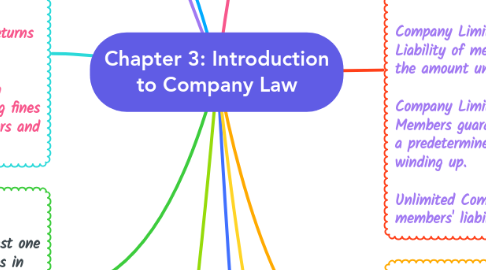Chapter 3: Introduction to Company Law
Ayuni Azaliにより

1. Company Constitution: Adopting a constitution is optional for companies limited by shares and unlimited companies. Companies limited by guarantee are required to have a constitution.
2. Compliance Obligations: Companies are required to maintain proper accounting records and submit annual returns to SSM. Non-compliance can result in significant penalties, including fines and imprisonment for directors and officers.
3. Incorporation Requirements: A company must have at least one director who ordinarily resides in Malaysia. A private company must have at least one director, while a public company must have a minimum of two directors.
4. Joint Ventures (JV): Incorporated Joint Venture: Structure: Partners create a new, separate legal entity (often called a Special Purpose Vehicle or SPV) to conduct the joint venture's operations. Legal Implications: The SPV is distinct from its founding companies, capable of owning assets, incurring liabilities, and entering into contracts independently. Liability: The SPV bears its own liabilities, generally shielding the parent companies from direct responsibility for its debts. Unincorporated Joint Venture: Structure: Partners collaborate based on a contractual agreement without forming a new legal entity. Legal Implications: The joint venture does not have a separate legal personality; instead, each partner retains their individual legal identity. Liability: Partners may be jointly and severally liable for the venture's obligations, depending on the terms specified in their agreement.
5. Subsidiary Company: Definition: A subsidiary is a company controlled by another company, known as the parent or holding company. Control is typically established when the parent company: Holds more than 50% of the subsidiary's voting shares. Has the authority to appoint the majority of the subsidiary's directors. Controls more than half of the voting power in the subsidiary company. Separate Legal Entity: Despite being controlled by the parent company, a subsidiary operates as an independent legal entity: It can own assets, incur liabilities, and enter into contracts in its own name. It is responsible for its own debts and obligations, protecting the parent company from direct liability.
6. Governing Legislation: The Companies Act 2016 (Act 777) is the principal statute regulating companies in Malaysia. It came into effect on January 31, 2017, replacing the Companies Act 1965.
6.1. The Law: Companies Act 2016 Purpose and Scope: It outlines the legal requirements for company formation, management, responsibilities of directors, shareholders' rights, and procedures for corporate restructuring and winding up.
7. Regulatory Authority: The Companies Commission of Malaysia (Suruhanjaya Syarikat Malaysia or SSM) is the statutory body responsible for overseeing company incorporation, registration, and compliance with corporate legislation.
7.1. The Statutory Body: Companies Commission of Malaysia (SSM) Establishment and Role: It serves as the regulatory authority responsible for enforcing the provisions of the Companies Act 2016. Functions and Responsibilities: SSM's core functions include: SSM Incorporating companies and registering businesses. Ensuring compliance with corporate legislation through enforcement and monitoring activities. Providing company and business information to the public. Promoting good corporate governance practices.
8. Types of Companies: Companies can be incorporated as: SSM Company Limited by Shares: Liability of members is limited to the amount unpaid on their shares. Company Limited by Guarantee: Members guarantee to contribute a predetermined amount in case of winding up. Unlimited Company: No limit on members' liability.
9. Private vs. Public Companies: Private Company: Restricted rights to transfer shares, limited to 50 shareholders, and prohibited from inviting the public to subscribe for shares or debentures. Public Company: Can offer shares to the public and has no restriction on the number of shareholders.
10. Corporate Governance: The Act outlines the duties and responsibilities of directors, emphasizing accountability and transparency. It introduces provisions for corporate rescue mechanisms like corporate voluntary arrangements and judicial management


